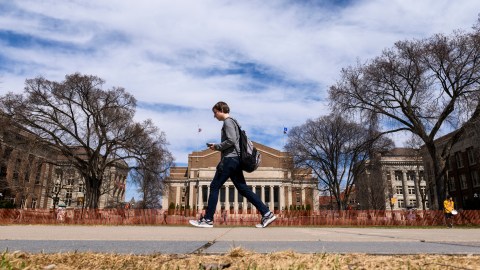Should students get a discount if they won’t be on campus because of COVID-19?

Stephen Maturen/Getty Images
Not long after the COVID-19 pandemic caused colleges to start teaching remotely, students balked at the idea of paying full tuition for online learning.
It’s not hard to understand why. After all, they were not getting the football and basketball games, student clubs, access to labs and the library and the out-of-class conversations that are all part of the typical campus experience.
Although students who study online will not pay the room, board and activities fees that typically cover nonacademic costs, concern about paying full tuition continues this fall, as many universities opt to continue online instruction in the interest of keeping students, faculty and staff safe from the pandemic.
Is it right to expect to pay less tuition for online learning? Or are colleges justified in charging the full tuition price when classes – at least at many schools – won’t be taking place on campus?
As a longtime college admissions and enrollment leader – and now as a professor of higher education – I have some insights. One of the most important is that fewer than one in five families pay the full price for in-person instruction to begin with. They are getting a break through scholarships and need-based grants from the colleges. In other words, most students are already getting a discount.
Price versus cost
In addition, it’s important to understand the difference between the price of education and the cost of education. These two things might often be misunderstood because the terms “price” and “cost” are often used interchangeably as though they are the same. But there’s a big difference between the two.
Price is the amount of money charged to a consumer – in this case a student – for a good or service. Cost is the amount of money the provider spends to produce that good or provide that service. Unlike in business, the price colleges charge – that is, tuition – is almost always less than the cost to provide instruction. The difference is covered by taxpayers and grants at public colleges and by endowment earnings, gifts and grants at private colleges.
In other words, even when their families are paying “full price,” Americans are not paying for the full cost of their education.
However, the cost of instruction during the pandemic has actually increased due to the need for new technology platforms, training and online instructional support. Faculty are still teaching and are available to students for extra help and consultation. And because some students and staff will be on campus even if teaching is primarily online, colleges have spent millions of dollars updating and maintaining their campuses for COVID-19 safety.
With the toll of the pandemic bearing down on our nation and its colleges and universities, that may not be something that students and their parents necessarily want to hear. They see that they are being asked to pay “in-person” tuition prices for remote learning and feel like it’s a ripoff.
However, it is important to understand that in expecting colleges to reduce tuition when they are paying more to deliver instruction is to ask colleges to take on an even bigger share of the cost than they already do.
Financial aid factors
Even if schools offered “online discounts,” it may not make as big a difference as people think because of the way that financial aid works.
At four-year public and nonprofit private colleges and universities, 85% of undergraduates receive financial aid. These students not only benefit from a list price that is lower than the cost borne by colleges, but they are getting a further discount in price through financial aid.
This leads to an important point.
Financial aid is based on the price charged minus what a family would be expected to pay, based on a federal formula. So, if tuition were lowered, students would get less financial aid and would therefore be expected to pay the same amount of money no matter what the tuition charge.
As a result, even at the colleges offering an online discount, the students who need that discount the most are going to benefit the least. For example, if tuition is US$40,000 and you are expected to pay $10,000, you might get $30,000 in various forms of aid. If tuition is reduced to $36,000, you are still expected to pay $10,000, and you might get $26,000 in aid.
The tab for tuition does not generally cover out-of-class experiences such as student activities and residence hall functions. When going remote, colleges will not be charging residence hall, food and activities fees. That means colleges will lose revenue on those things. They will lay off some staff who work with student groups.
So while charges for room and board and student activities and athletics fees will be eliminated for online-only instruction, tuition pricing will either be untouched or be slightly reduced. But the ability for a college to reduce tuition will depend largely on the school’s financial health.
Price adjustments
Even in light of these realities, some schools are still lowering tuition for online learning.
Although they’d rather not, many colleges with small endowments and limited state aid will lower tuition. These schools typically are not as well known and risk losing students if they do not charge less. They will take in less money per student but expect to recover at least some of the loss with a larger enrollment.
Some of the wealthiest schools have already reduced tuition at the edges.
Williams College, a small liberal arts school in Massachusetts, with its $3 billion endowment and 2,000 students, cut tuition by 15%. In so doing, its provost admitted to being concerned about the pressure this would put on less well-endowed competitors to do the same.
However, Williams’ leaders thought it was the right thing to do for their students.
Princeton, with a $26 billion endowment, applied a 10% discount to its full-freight tuition. When a college has the resources, this is certainly easier to do.
Just below these institutions are schools that are well known but not as wealthy. They will not likely lose students because of tuition pricing but cannot afford to offer online discounts.
Dickinson College, a liberal arts school in Pennsylvania, where I served as vice president from 1999-2009; Smith College, also in Massachusetts; and Carnegie Mellon University, in Pittsburgh, are examples of institutions not offering online discounts.
Dickinson College president Margee Ensign sought to reassure students that the online fall semester will “feature the same expert faculty and the same small class sizes,” and will also “maintain rigor” and “close student-faculty relationships.”
Skepticism and potential benefit
Predictably, many students are not convinced that online instruction will be of the same quality as in-person. Plus, many students are understandably upset because they did not expect to spend their college days doing remote learning.
But there is a potential long-term benefit.
The COVID-19 pandemic has forced higher education leaders to control costs by changing priorities and eliminating nonessential spending in ways that they didn’t have to think as much about doing before. As a result, perhaps tuition increases will moderate in the short term, and stay more affordable in the future. After all of the stress and pain caused by the pandemic, this may be one positive change.
This article is republished from The Conversation under a Creative Commons license. Read the original article.





